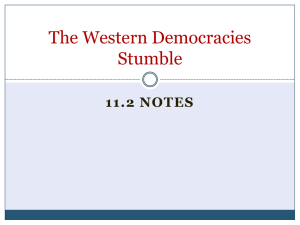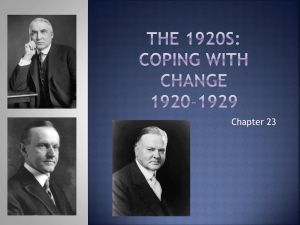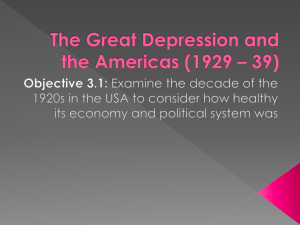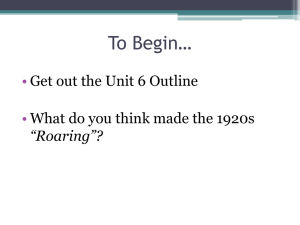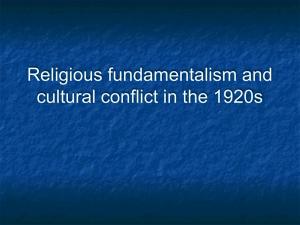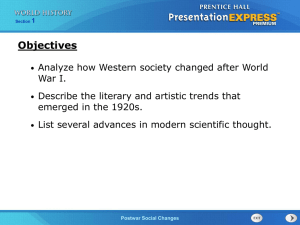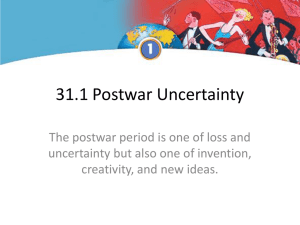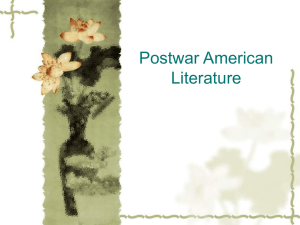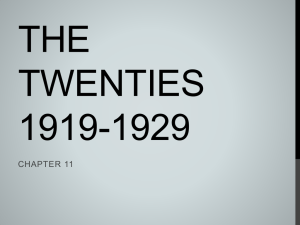CH012Pres
advertisement
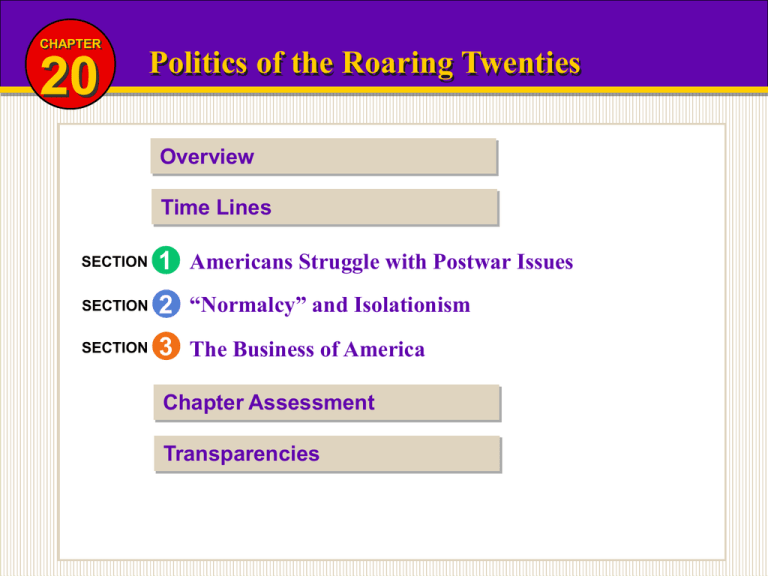
CHAPTER 20 Politics of the Roaring Twenties Overview Time Lines SECTION 1 Americans Struggle with Postwar Issues SECTION 2 “Normalcy” and Isolationism SECTION 3 The Business of America Chapter Assessment Transparencies CHAPTER 20 Politics of the Roaring Twenties “The business of America is business.” President Calvin Coolidge THEMES IN CHAPTER 20 Economic Opportunity Science and Technology HOME CHAPTER 20 Politics of the Roaring Twenties “The business of America is business.” President Calvin Coolidge What do you know? • What images come to mind when you think of the Roaring Twenties? • What people and events characterized the 1920s? • What names have been given to other decades? What might be a good nickname for the 1990s? HOME CHAPTER 20 Time Line The United States 1920 The 19th Amendment is ratified. 1921 Saco and Vanzetti are convicted. The Federal Highway Act funds a national highway system. 1922 Coal miners in Scranton, Pennsylvania go on strike. 1924 The Teapot Dome scandal erupts. 1925 A. Philip Randolph organizes Brotherhood of Sleeping Car Porters. 1928 Kellogg-Briand Pact is signed. HOME CHAPTER 20 Time Line The World 1921 Chinese Communist Party is founded in Shanghai. Vladimir Ilich Lenin adopts the New Economic Policy. 1922 Benito Mussolini is appointed prime minister in Italy. 1923 Adolf Hitler’s putsch in Germany fails. 1924 Vladimir Illich Lenin, founder of the Soviet Union, dies. 1926 Hirohito becomes emperor of Japan. 1928 Joseph Stalin launches the first five-year plan in the USSR. 1929 Institutional Revolutionary Party is organized in Mexico. HOME SECTION 1 Americans Struggle with Postwar Issues HOME Learn About postwar conditions in America. To Understand how fear of communism affected civil liberties and the labor movement. SECTION 1 Americans Struggle with Postwar Issues Key Idea The Russian Revolution brings a Communist government to power. Many Americans fear that a similar revolution will occur in the United States. Political radicals and labor activists meet with increasing resistance. HOME SECTION 1 Americans Struggle with Postwar Issues HOME Section 1 Assessment SEQUENCING What were the major events involving labor unions between 1917 and 1929? 1919 Boston police strike begins. 1925 Steel strike begins under William Z. Foster. Coal strike begins under John L. Lewis. 1917 A. Philip Randolph organizes the Brotherhood of Sleeping Car Porters. 1929 1920 Steel strike is broken. SECTION 1 Americans Struggle with Postwar Issues Section 1 Assessment FORMING AN OPINION Do you think Americans were justified in their fear of radicals and foreigners in the decade following World War I? THINK ABOUT • the goals of the leaders of the Russian Revolution • the impact of radicals in the United States • the challenges facing the United States HOME SECTION 1 Americans Struggle with Postwar Issues Section 1 Assessment ANALYZING What factors led union organizers to call so many strikes in 1919? THINK ABOUT • economic factors • labor leaders’ determination to fight for worker rights HOME SECTION 2 “Normalcy” and Isolationism Learn About the policies of the Harding administration. To Understand the development of postwar isolationism and the immigration quota system. HOME SECTION 2 “Normalcy” and Isolationism Key Idea The Republicans return to isolationism and the kind of policies that characterized the period before the Progressive Era and its reform movements. HOME SECTION 2 “Normalcy” and Isolationism HOME Section 2 Assessment SUMMARIZING Did the following events benefit, have a mixed impact, or harm the country? Election of Harding Naval disarmament agreement Kellogg-Briand Pact signed Fordney-McCumber Tariff passed Dawes Plan implemented Increase in immigration in 1921 Immigration quotas created Teapot Dome scandal uncovered SECTION 2 “Normalcy” and Isolationism Section 2 Assessment GENERALZING How do you think the Harding administration viewed the role of America in world events? THINK ABOUT • policies on trade and tariffs • efforts to enforce peace • attitudes toward immigrants HOME SECTION 2 “Normalcy” and Isolationism Section 2 Assessment EVALUATING How successful was Harding in fulfilling his campaign pledge of returning the country to “normalcy”? THINK ABOUT • events in foreign relations • changes in immigration laws • scandals during Harding’s administration HOME SECTION 3 The Business of America HOME Learn About the impact of automobiles, electric power, advertising, and installment buying on the American consumer. To Understand how consumer goods became the foundation of the business boom of the 1920s. SECTION 3 The Business of America Key Idea During the prosperous 1920s, the automobile industry and other industries flourished. America’s standard of living rises to new heights. HOME SECTION 3 The Business of America HOME Section 3 Assessment SUMMARIZING What events illustrate the technology and business changes of the 1920s? Development of the automobile industry Invention of new electrical appliances Technology and Business Changes of the 1920s Expansion of the airline industry Spread of modern advertising SECTION 3 The Business of America INTERPRETING Section 3 Assessment 3 Do you agree with President Coolidge’s statement “The man who builds a factory builds a temple—the man who works there worships there.”? THINK ABOUT • the goals of business and of religion • the American support of business • the difference between workers and management HOME SECTION 3 The Business of America Section 3 Assessment DRAWING CONCLUSIONS Do you think the changes in the 1920s gave Americans more control over their lives? THINK ABOUT • the impact of new technology • the influence of advertising • the results of installment buying HOME Chapter 20 Assessment 1. What impact did the Russian Revolution have on the United States? 2. Explain how the Red Scare, the Saco and Vanzetti case, and the rise of the Ku Klux Klan reflected concerns held by many Americans. 3. What evidence suggests that strikes were a risky activity for workers during the 1920s? 4. What did Harding want to do to return America to “normalcy”? 5. What evidence shows that the United States was interested in an isolationist foreign policy? HOME Chapter 20 Assessment 6. Describe the primary goal of the immigration quota system established in 1921 and amended in 1924. 7. Summarize the Teapot Dome scandal. 8. How did changes in technology in the 1920s influence American life? 9. Describe the new methods used by advertisers beginning in the 1920s. 10. What evidence suggests that the prosperity of the 1920s was not on a firm foundation? HOME
